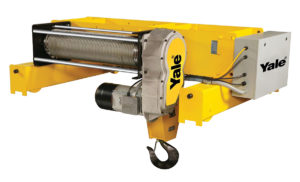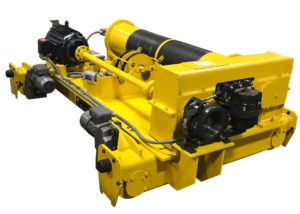Choosing the Correct Packaged or Custom Hoist
Selecting the appropriate hoist for your operations can greatly impact both efficiency and safety. When choosing between packaged and custom hoists, it’s important to understand their unique features and benefits. Packaged hoists are pre-engineered, cost-effective solutions ideal for lighter applications and are available in various configurations. Custom built-up hoists, on the other hand, are designed for heavy-duty use, offering higher capacities and specialized features tailored to your specific needs. This blog will guide you through key considerations to help you make an informed decision, ensuring your hoist meets your operational demands effectively.
Differences Between Packaged and Custom Built Hoists
A crucial part of a crane purchase is the hoist. The hoist is a device used for lifting or lowering a load by means of a drum or lift-wheel around which rope or chain wrap. Hoists may be integral to a crane or mounted in affixed position, permanently or temporarily.
When a hoist is mounted to a trolley on a fixed monorail, two directions of load motion are available: forward or reverse, up or down.
When the hoist is mounted on a crane, three directions of load motion are available: right or left, forward or reverse, up or down.
Packaged Equipment

We offer both “packaged” hoists and custom built-up hoists. The term “packaged” hoists refers to pre-engineered cataloged hoists that are typically designed to handle lighter applications and are a more cost-effective option. We work closely with a variety of different hoist manufacturers and can help advise the best option for your application.
Some highlights of packaged hoists are:
- Typically suited for lighter capacity and slower speeds
- Lighter service use
- Available in a variety of configurations: top mounted, deck mounted, monorail
- Wire rope or chain available
- Available for some special applications
- Lifting capacities range to 35 tons
- Range of lift up to 40 feet
- Also available for explosion proof applications
Custom Built-Up Equipment

A custom built-up hoist refers to hoists that are designed to withstand heavy duty applications and service. We manufacture our built-up hoists in house to suit a variety of standard and specialized industries. Custom built-up hoists are a more expensive option because they cater to heavier duty use, but our hoists are built to last for years of reliable service.
Some highlights of built-up hoists are:
- Capacities of up to 200 tons
- AC or DC voltage
- Non-mechanical load brake design
- Decked-over trolley frame
- Upper and lower limit switches
- Double-reeved for true vertical lift
- Customizable for any application
Questions to Consider
When selecting the proper hoist there are many factors to consider:
- The weight of the load including below-the-hook lifting, load supporting and positioning devices
- Physical size of the load
- Design for center of gravity (for control and stability)
- Lift – the vertical distance the load can be moved
- Clearance Considerations
- Headroom
- Obstacles to be cleared during load transfer
- Design for vertical lift including holding device height
- Lifting Speed Considerations
- Distance load needs to be raised and lowered
- Frequency of use
- Required positioning accuracy
- Nature of the load being lifted
Important Factors
Another important factor is the Hoist Duty Classification. These classifications are based on a number of factors. These factors determine the classification your hoist needs to be. These classifications were created by the HMI and ASME Associations and are to be used as reference only. For better detail our sales team can answer any questions.
| Operating Based on 65% of Capacity | |||||
| HMI Class | Uniform Usage | Infrequent Use | Details | ||
| Max On Time (Min./Hr.) | Max Starts (Hr.) | Max On Time from Cold Start | Max Starts | ||
| H1 | 7.5 min. (12.5%) | 75 | 15 | 100 | Powerhouse and Utilities, infrequent handling, hoists used to primarily to install and service heavy equipment, loads frequently approach capacity and hoist idle for long periods between use |
| H2 | 7.5 min. (12.5%) | 75 | 15 | 100 | Light machine shop fabricating, service and maintenance, loads and utilization randomly distributed; rated loads infrequently handled. Total running time not over 12.5% of the work period |
| H3 | 15 (25%) | 150 | 30 | 200 | General machine shop fabricating, assembly, storage and warehousing; loads and utilization randomly distributed. Total running time not over 25% of work period |
| H4 | 30 (50%) | 300 | 30 | 300 | High volume handling of heavy loads, frequently near rated load in steel warehousing, machine and fabricating shops, mills, and foundries with total running time not over 50% of the work period, manual or automatic cycling operations of lighter loads with rated loads infrequently handled such as in heat treating or plating operations, with total running time frequently 50% of the work period |
| H5 | 60 (100%) | 600 | N/A (Note 1) | N/A (Note 1) | Bulk handling of material in combination with buckets, magnets or other heavy attachments. Equipment often cab operated. Duty cycles approaching continuous operation are frequently necessary. User must specify exact details of operation, including weight of attachments. |
A crane duty group tells which kind of duty the crane is for; the range is from light duty up to very heavy duty. It is vital to define the needs and estimate the use because of safety reasons and for to ensure a long working life for the crane.
As to the types of cranes covered under CMAA (Crane Manufacturers Association of America) Specification No. 70 (Top Running Bridge and Gantry Type Multiple Girder Electric Overhead Traveling Cranes); there are six (6) different classifications of cranes, each dependent on duty cycle. Within the CMAA Specification is a numerical method for determining exact crane class based on the expected load spectrum. This chart is to be used as reference only. For better detail our sales team can answer any questions
Aside from this method, the different crane classifications, as generally described by CMAA, are as follows:
| CMAA Class | Description | Details |
| A | Standby or Infrequent Service | This service class covers cranes where precise handling of equipment at slow speeds with long idle periods between lifts. Capacity loads may be handled for initial installation of equipment and for infrequent maintenance. Typical examples are cranes used in powerhouses, public utilities, turbine rooms, motor rooms, and transformer stations. This is the lightest crane as far as duty cycle is concerned. |
| B | Light Service | This service class covers cranes where service requirements are light and the speed is slow. Loads vary from none to occasional full capacity. Lifts per hour would range from 2 to 5, and average 10 feet per lift. Typical examples are cranes in repair shops, light assembly operations, service buildings, light warehousing, etc. |
| C | Moderate Service | This service covers cranes whose service requirements are deemed moderate, handling loads which average 50 percent of the rated capacity with 5 to 10 lifts per hour, averaging 15 feet, with not over 50 percent of the lifts at rated capacity. In terms of numbers, most cranes are built to meet Class C service requirements. This service covers cranes that may be used in machine shops or paper mill machine rooms. |
| D | Heavy Service | In this type of service, loads approaching 50 percent of the rated capacity will be handled constantly during the work period. High speeds are desirable for this type of service with 10 to 20 lifts per hour averaging 15 feet, with not over 65 percent of the lifts at rated capacity. Typical examples are cranes used in heavy machine shops, foundries, fabricating plants, steel warehouses, container yards, lumber mills, etc., and standard duty bucket and magnet operations where heavy duty production is required. |
| E | Severe Service | This type of service requires a crane capable of handling loads approaching the rated capacity throughout its life with 20 or more lifts per hour at or near the rated capacity. Typical examples are magnet, bucket, magnet/bucket combination cranes for scrap yards, cement mills, lumber mills, fertilizer plants, container handling, etc. |
| F | Continuous Severe Service | In this type of service, the crane must be capable of handling loads approaching rated capacity continuously under severe service conditions throughout its life. Typical examples are custom designed specialty cranes essential to performing the critical work tasks affecting the total production facility, providing the highest reliability with special attention to ease of maintenance features. |
We Have the Answers
Questions on any of this information we covered in this article? We have a very knowledgeable team who can answer any questions or provide more detail on any of the above topics. G.W. Becker, Inc. works with a variety of hoist manufacturers, as well as manufacturing in-house, to get you the best equipment for your specific application.
